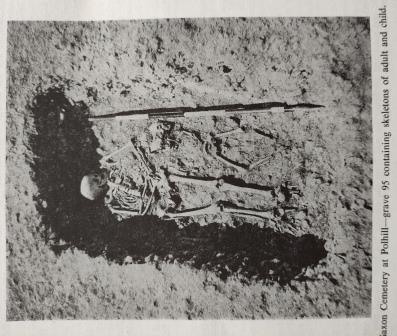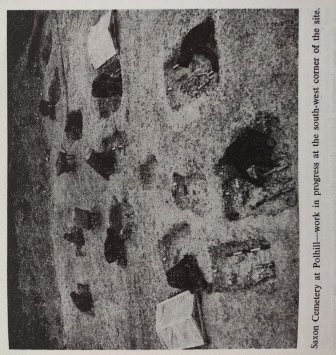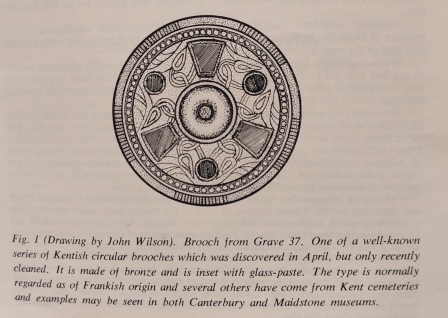Saxon Cemetery at Polhill, near Sevenoaks KAR April 1965
In October 1964, heavy machinery employed on the new Sevenoaks By-pass road scheme disturbed a number of Saxon graves close to the foot of Polhill. Other Saxon graves, clearly forming part of a large cemetery, had been destroyed immediately to the East by other roadworks on at least three occasions in the previous hundred years.
The discovery was reported by the Sevenoaks police to Mr. D. B. Kelly at Maidstone Museum, who got in touch with me as the site lay within the area covered by the West Kent Border Archaeological Group, and a visit to the site revealed the need for immediate emergency excavation. The K.C.C. engineer in charge of the scheme was approached, the contractors informed, financial sup- port was obtained from the Ministry of Public Building and Works, and an urgent appeal for help was sent to other local groups. In response to this appeal, eleven members of the West Kent Border Group (including boys from the Chislehurst and Sidcup Grammar School), three members of the Otford Historical Society and one each from the Lower Medway, Gravesend and Orpington Groups gave assistance. This was the first instance of inter-Group help with such emergency operations now being organised on a County basis.
Work began immediately and continued for the next five days, often into the night in near-freezing conditions. During this period, 16 graves were located, exca-vated, recorded, photographed and cleared, and it appears that few, if any, were missed in the threatened area. Each grave had been dug 10 to 24 inches into solid chalk, and all were aligned roughly East-West, with heads at the west end. Of the 15 skeletons recovered, one at least was that of a child; of the rest, 12 had been buried with small iron knives, normally placed at the left waist, and one with an iron spear along the right side of the body. Three graves contained bronze buckles and a stud. These few finds suggest that the cemetery dates between A.D. 550-700.
With these 16 new graves, the known total is now 35, and clearly many others must have been destroyed years ago. The cemetery, flanking the Pilgrim's Way, is very similar to several others known in Kent as to date, siting, orientation, grouping and grave-goods. Two of the nearest and best known of these occur at Horton Kirby, in the Darent Valley, and at Holborough, in the Medway Valley, both within 12 miles.
B J. PHILP
The Saxon Cemetery at Polhill KAR August 1967
The emergency excavation sponsored by the K.A.R.G.C. was completed as scheduled early in April (K.A.R. No. 7, page 3). In all another 66 Anglo-Saxon graves were located and examined in detail.
The excavation lasted for 21 days during which time a total of 83 archaeolo- gists, drawn from Kent, Surrey and London assisted with the work. The hard- core was supplemented by members from Fawkham, Lower Medway, Reculver, Sittingbourne, Tonbridge and London Field Study groups. Particular thanks are due to all diggers for some very hard work and for the successful outcome of the expedition.
The Army authorities, under Major B. A. Lipscombe, R.E., kindly cleared the site and also back-filled on completion of the work. Thanks are also due to Mr. A. G. Laver for permission to excavate without restriction and for his interest in the work.
The site, situated close to the Pilgrim's Way some three miles north of Sevenoaks, was first discovered in about 1839. Then several skeletons and a number of weapons were uncovered when a road was being cut into the hillside. Another 13 graves were noted in 1956 when the road was widened and 16 more were excavated in 1964 (K.A.R. No. 1, page 2) when the Sevenoaks By-pass scheme began. Other graves have been disturbed at various times.
The area to the west of the earlier discoveries is to become part of yet another road-scheme and the emergency excavations were carried out in the hopes that more graves might be saved. The project had the backing of the Ministry of Public Building and Works.
After the removal of the top soil from about 2 acres of the site the area was cleaned by hand down to solid chalk into which the graves had been dug. Each grave was then carefully excavated and the skeletons and grave-goods exposed so that a complete photographic record could be made. The contents of each grave were then drawn on the one-inch scale, fully recorded and then removed.
All of the graves were aligned roughly east-west as previously noted. Most of the skeletons lay on their backs with their arms and legs straight and all the heads were at the western ends. The graves had been dug some 3 to 30 inches into the chalk and many formed perfect rectangles with neatly-cut corners though several others were almost ovoid in shape. The spacing of the graves varied between I foot and 20 feet.
Of the 66 graves located 51 had contained a single skeleton, 14 contained two skeletons and one contained 3. Single burials were the normal practice in Saxon times though occasionally doubles are found, but triples are rare.
Of the doubles 8 contained the skeletons of an adult and a child, but the others all contained the skeletons of two adults. In four of the double graves one of the skeletons was superimposed across the other and must have been inserted at a later date. It seems that all the double graves must represent family burials and from this it seems clear that each grave was marked in some individual way. The triple grave appears to have contained the adult skeletons of a male and two females. Its irregular outline and the arrangement of the bones suggests a hurried burial.
Of the 82 skeletons found 26 appear to be those of children. A study of some of the skeletal remains from the graves found previously on the site showed some interesting statistics. About half of the people represented had died by the age of 30 and the rest mostly between the ages of 40 and 45 with the oldest person being somewhere about the age of 55.
At the north-west end of the cemetery was a line of five barrows. Four contained single graves and the fifth contained a child's grave and a large double containing an adult and a child. These graves were encompassed within shallow ditches generally about 12-15ft. in diameter. A narrow causeway had been left on the east sides and doubtless the soil from the ditches had been heaped over the graves to form a low mound.
Most of the graves contained grave-goods though none was rich. In the men's graves were sometimes small iron knives, iron spearheads and sometimes buckles. Only three had contained swords, but no shield-boss was found on the site. The women's graves often contained iron knives, small beads and bronze rings. One was found to contain a bone comb in a very fragmentary state. Some of the children had also been buried with iron knives. The finds from the cemetery have been tentatively dated to A.D. 550-650.
 |
 |
It is also clear that several of the graves had originally contained coffins. Slight traces of these were found and in some graves the chalk rubble which had been packed against the coffins remained in place although the coffin had decayed. No iron nails were found and it seems that the wooden coffins must have been secured with wooden pegs.
The cemetery probably served a nearby village, such as Otford, or it may have been used by several scattered communities. Its site on a prominence is typically pagan and the depositing of grave-goods was largely discontinued in Christian times. The community concerned may have been converted to Christianity some- time during the 7th century and subsequent burials may have been made close to the habitation site as in later times. Very seldom have pagan domestic sites been located and it may be that these lie buried beneath existing villages.
The number of graves recorded at Polhill is now 102 and clearly many more have been destroyed. It seems probable that the total number must have been in the region of 150-200 graves. Certainly the cemetery is the largest so far located in West Kent and it compares with some of the very large ones in East Kent. It must have covered some three acres of ground and it is possible that the limits of the site have not yet been found.
Brian Philp, Emergency Excavations.
Further Excavations at Polhill KAR November 1967
The extensive emergency excavations undertaken by the K.A.R.G.C. at Polhill in March and April (K.A.R. No. 9, page 2) uncovered another 66 Saxon graves and substantially cleared the cemetery. The excavation was, however, resumed for two weeks in July in order that the western limits of the site could be located and a series of post-holes examined in detail. The project again had the backing of the Ministry of Public Building & Works and the active support of several local research groups. The hard core was com- prised of members of the Otford and West Kent Border Archaeological Groups who are to be congratulated on their hard work. Mr. A. G. Lavers is to be thanked again for permission to excavate without restriction. Lenfield Engineering Ltd. of Maidstone and Ashford kindly cleared the site without charge using their Massey- Ferguson machines.
Another 5 graves were located in the area opened and these were duly recorded and excavated. This brings the total number of known graves up to 107 of which 88 have been rescued under the emergency scheme. One of the new graves was found to contain two skeletons and this increases the number of doubles graves to 15, a figure which no other Kentish cemetery site can match. Another grave was found to be encompassed within a shallow ditch which increases the number of barrows to six. It too had an eastern causeway and was located in the north-west corner of the cemetery. The skeleton in this grave (Grave 106) was that of a child buried in a wooden coffin. The graves produced the usual small iron knives and buckles.

It now seems clear that both the southern and western limits of the site have been reached and that the site originally covered some four acres. The northern edge lies beneath high mounds of spoil deposited from an adjacent quarry and it is just possible that isolated burials remain to be found. The story of the discovery of this site in the 19th century and its subsequent partial destruction on a number of occasions is well-known. It is hoped that the recent rescue work will at last prove to be the final chapter in the sorry saga.
Brian Philp, Emergency Committee.
